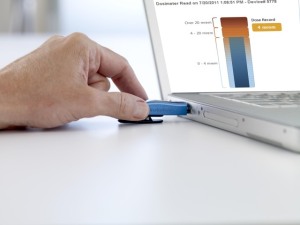by
Carol Ko, Staff Writer | April 08, 2013

Mirion’s current
Instadose dosimeter
From the April 2013 issue of HealthCare Business News magazine
Who should be required to wear a dosimetry badge? Is there such a thing as overbadging? Are hospitals currently lagging behind on badge safety? While this topic may seem unassuming on the surface, opinions differed widely and emotions ran surprisingly high when DOTmed Business News asked industry experts to weigh in with their thoughts.
Radiation badges for routine personnel monitoring have been around since 1942 and are worn by individuals who work around radioactive equipment to record their exposure to toxic radiation. Most hospitals now follow a standard routine: every month, employees turn in their radiation badges to the radiation safety officer, who then sends the badges to be read by a dosimetry company. The data is then sent back to the safety officer, who uses the information to monitor dose exposure among staff. The cost of badge subscription services varies substantially from hospital to hospital.
Badging is a must for many staff members working with imaging equipment. Interventional fluoroscopists, for example, are often close to receiving their legal limit of radiation exposure. Documenting unusually high radiation levels helps radiation safety officers identify the root cause to prevent further excessive exposure. And monitoring radiation dose among staff is also a good way to track exposure among patients.
Federal law requires badges for all personnel likely to receive more than 10 percent of the federal radiation dose limit. Under these laws, occupational workers whose badge readings have remained at zero for long periods of time are technically not required to wear them.
Beyond these guidelines, badging requirements are largely determined by radiation safety officers and therefore can vary from facility to facility. However, liability fears have spurred many hospitals to badge staff members unlikely to receive radiation levels even close to approaching the federal limit.
Safety tool or high-tech comfort device?
With the rise of imaging equipment in the OR, and with hospitals seeking to reduce expenses across the board, some experts believe badging low-risk workers may be an unnecessary drain on hospital resources.
“Certainly some hospitals are badging personnel who don’t need to be badged,” says Geoffrey West, president and chief medical physicist of West Physics Consulting. Radiation experts like West think many hospitals can and should reduce badge usage among staff.
